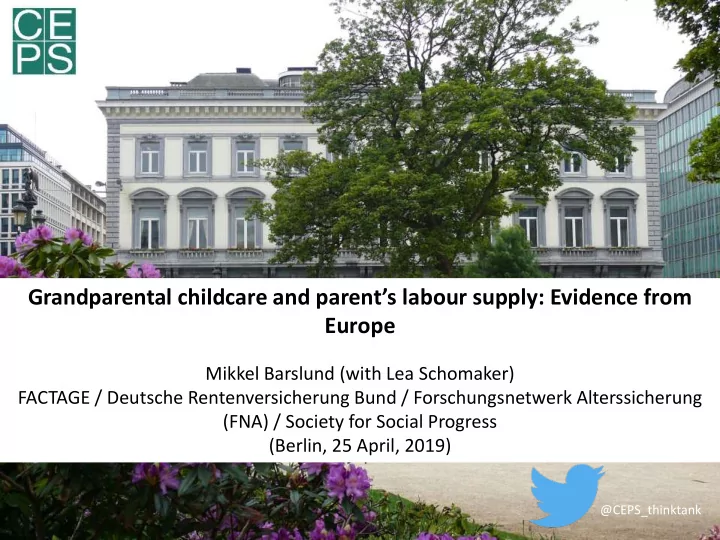

Grandparental childcare and parent’s labour supply: Evidence from Europe Mikkel Barslund (with Lea Schomaker) FACTAGE / Deutsche Rentenversicherung Bund / Forschungsnetwerk Alterssicherung (FNA) / Society for Social Progress (Berlin, 25 April, 2019) @CEPS_thinktank
Acknowledgements Joint work with Lea Schomaker. Part of FACTAGE project – a Joint Programming Initiatve project under More Years Better Lives programme. BELSPO (Belgian Science Policy Office) finances ‘Belgian part of project’. More info: www.factage.eu
The historical importance of grandparents Photo credits: Catherine Scott - Matti, CC BY-SA 2.0, Wiki Commons
Motivation Demographic change Need for longer working lives (current & future) More time used for employment by grand-parental generation Potentia ial les less tim time use sed for r grandparental l child ildcare Parent’s lab labour su supply ly may go down
Potential implications Th The e link: Potential less time used for grandparental childcare Parent’s labour supply may go down Has as impl plicatio ions for: or: Projections of overall labour supply (from e.g pension reforms), dynamic effects. Gender equality (if differentiated gender effects). Inequality (within generations). Fertility. Academic outcomes of grandchildren. General implications for amount of volunteering work.
Related literature Main studies: Dimova/Wolff (2011) - Europe (SHARE) Assave et al. (2012) – 7 countries (Gender & Generations survey) Compton/Pollak (2014) – US Arpino et al. (2014) – Italy Kanji (2018) - UK Our contribution: revisit EU countries (more) explicit treatment of causal effect Can include more data points and therefore allow for more heterogeneity (effect of children’s age / mother’s education)
Data – SHARE survey Data taken from wave 1-6 of the SHARE survey (2004/5 -2015) Cover 12 countries: AT, BE, CZ, DK, FR, DE, EL, IT, NL, ES, SE and CH. Our observed information: Dependent variable : mother’s and father’s employment status Independent variables : Grandparents caring at least weekly Number of children (of father and mother) Age of parent Age of youngest grandchild Condition on primary working age (25-54 y/o) and youngest child<10 y/o Total of 50,000+ observations
Some descriptive statistics Share of population being grandparent
Some descriptive statistics Labour Force Participation of Grandparents at Age 55-64 0.6 0.5 0.4 0.3 0.2 0.1 0 2004 2007 2011 2013 2015 Grandmothers Grandfathers All
Some descriptive statistics Some evidence that grandparental care has decreased.
Estimation The model 𝑛𝑝𝑢ℎ𝑓𝑠 𝑥𝑝𝑠𝑙𝑗𝑜 𝑗 = 𝛽 + 𝛿 ∙ 𝑠𝑏𝑜𝑒𝑞𝑏𝑠𝑓𝑜𝑢𝑏𝑚 𝑑ℎ𝑗𝑚𝑒𝑑𝑏𝑠𝑓 𝑗 + 𝑙 𝛾 𝑙 𝑦 𝑙𝑗 + 𝜁 𝑗 mother working is binary (working / not working) grandparental childcare is binary (caring at least weakly / not caring) x other controls Estimation either by OLS or Maximum Likelihood (probit / logit) Endogeneity Estimated partial correlation may not be causal. OLS-IV and IV-Probit, instruments: Distance between parent and grandparent (0/1, cutoff at 25km) Number of siblings of parent
Results (1/4) OLS – Pooled sample (1) (3) (5) (6) Dependent variable: WOMEN MEN WOMEN WOMEN parent’s work status Waves 4-6 Wave 1 (1/0) Weekly childcare 0.112*** 0.0097 0.093*** 0.138*** (incl. daily care) (0.00963) (0.00630) (0.0125) (0.0193) Observations 27,231 26,260 17,505 4,648 R-squared 0.140 0.055 0.131 0.134 Sample: SHARE waves 1, 2, 4, 5, 6. Parent aged 25-54 who has less than 5 children and at least one child who is 10 years old or younger. Note: *** p<0.01, ** p<0.05. OLS regressions.
Results (2/4) OLS-IV – Pooled sample Dependent variable: Employed Looking after grandchildren 0.134*** (at least once per week) (0.029) Kleibergen-Paap Wald rk F 891.76 statistic Hansen J statistic, Chi2(1) 0.195 (p=.66) Observations 24,709 R-squared 0.137 Sample: SHARE waves 1, 2, 4, 5, 6. Parent aged 25-54 who has less than 5 children and at least one child who is 10 years old or younger. Note: *** p<0.01, ** p<0.05. OLS regressions.
Results (3/4) OLS-IV – country specific results Sample: SHARE waves 1, 2, 4, 5, 6. Parent aged 25-54 who has less than 5 children and at least one child who is 10 years old or younger. Note: *** p<0.01, ** p<0.05. OLS regressions.
Results (4/4) Further results based on pooled sample: Grandchild age (some importance) Parents education (not very important) Macroeconomic importance (approx. 2% LS increase for 25-54 y/o women). On validity of instruments: Falsification procedure based on adults not (yet) parents.
Limitations A lot of noise in key measurements. One can criticize the instrumental strategy. Country heterogeneity large (child care service, parental leave policies). Longevity and increasing age of first birth
Concluding Link between grandparental care and maternal labour supply Country differences prevalent Large samples needed to tease out effects Speaks to the wider issue of ‘total effect’ of longer working lives.
18 @CEPS_ThinkTank info@ceps.eu Thank You! 1 Place du Congres, 1000 Brussels Tel: (+32 2)229 39 11
Recommend
More recommend